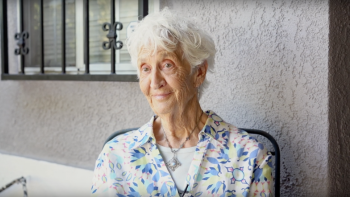
Neighbors build community through multifamily homes
Brenda’s Habitat for Humanity home is her happy place. “I love being here, and I never want to move,” says the 72-year-old.
With its widened doorways and halls, Brenda can maneuver her wheelchair into every room of her new home – something that wasn’t possible in her prior apartment. “I’ve never been able to live in a home that was accessible,” she says. “I just had to make do with what was available that I could afford.”
Brenda’s home is part of a Midland County Habitat community that includes four Habitat homes built as multifamily units. The units were designed to be sustainable and accessible, but Brenda’s also has a roll-in shower and lowered cabinets to ensure she can navigate her home easily and safely.

Brenda is thrilled to live in an accessible Habitat home.
Midland County Habitat decided to build multifamily units after conducting a housing need and market assessment study of the area with community partners. “The data told us we were largely a single-family home community and that there needed to be a diversity of housing options moving forward,” says Jennifer Chappel, Midland County Habitat president and CEO.
Lending a helping hand
“Neighbors can look out for each other, and we know each other here,” Brenda says of her new community.
Knowing her fellow Habitat homeowners came in handy when Brenda’s smoke alarm began beeping one night. She called her neighbor, Heidi, who came over to help her switch out the batteries.
Like Brenda, Heidi was looking for a safer environment to call home. Exposure to mold in a previous residence had wreaked havoc on her health. “I had a lot of health issues going on, but mold was a pretty big issue in that,” Heidi says.
During her build, Heidi was “emotionally overwhelmed” by the support of friends and family who volunteered to work alongside her and help make her dream of having a healthy home come true. “They’re all just happy that I’m in a healthy spot because they watched me go through such a tough time,” she says. “Now I’m somewhere where I can finally start to have a normal life.”
Building a more sustainable future
Brenda and Heidi’s homes were built with support from DuPont. The company provided funding and donated product to help construct the multifamily community, and its employees volunteered to help the families build their homes. DuPont staff members also identified and addressed air sealing and insulation opportunities in the homes’ designs, helping to make them more efficient. With DuPont’s help, Midland County Habitat’s multifamily homes achieved a high efficiency Energy Star HERS® rating. The HERS® Index is a nationally recognized system for evaluating a home’s energy performance in the U.S.
“The donated product is really what makes the energy efficiencies of these homes,” Jennifer says. “We know that the largest bill a homeowner will pay is their mortgage payment. And typically, your second largest bill is your utilities. These homes have an affordable mortgage, so the cost of housing is controlled. But energy use and consumption are lowered ensuring further savings. On average, these homeowners are paying about US$100 a month on energy bills year-round.”
“This home is much more energy efficient,” says Brenda, who has seen an improvement in her utility costs now that she’s moved into her Habitat home.
“At DuPont, we are committed to working with local communities like Midland to help ensure that everyone has access to energy-efficient and resilient homes,” says Tim Lacey, DuPont’s global vice president and general manager who also serves as a member of Midland County Habitat’s construction and repair and ad hoc flood recovery committees. “We’re proud to work with Habitat to help foster more affordable and sustainable housing solutions that will improve the lives of families, our communities and our world.”

